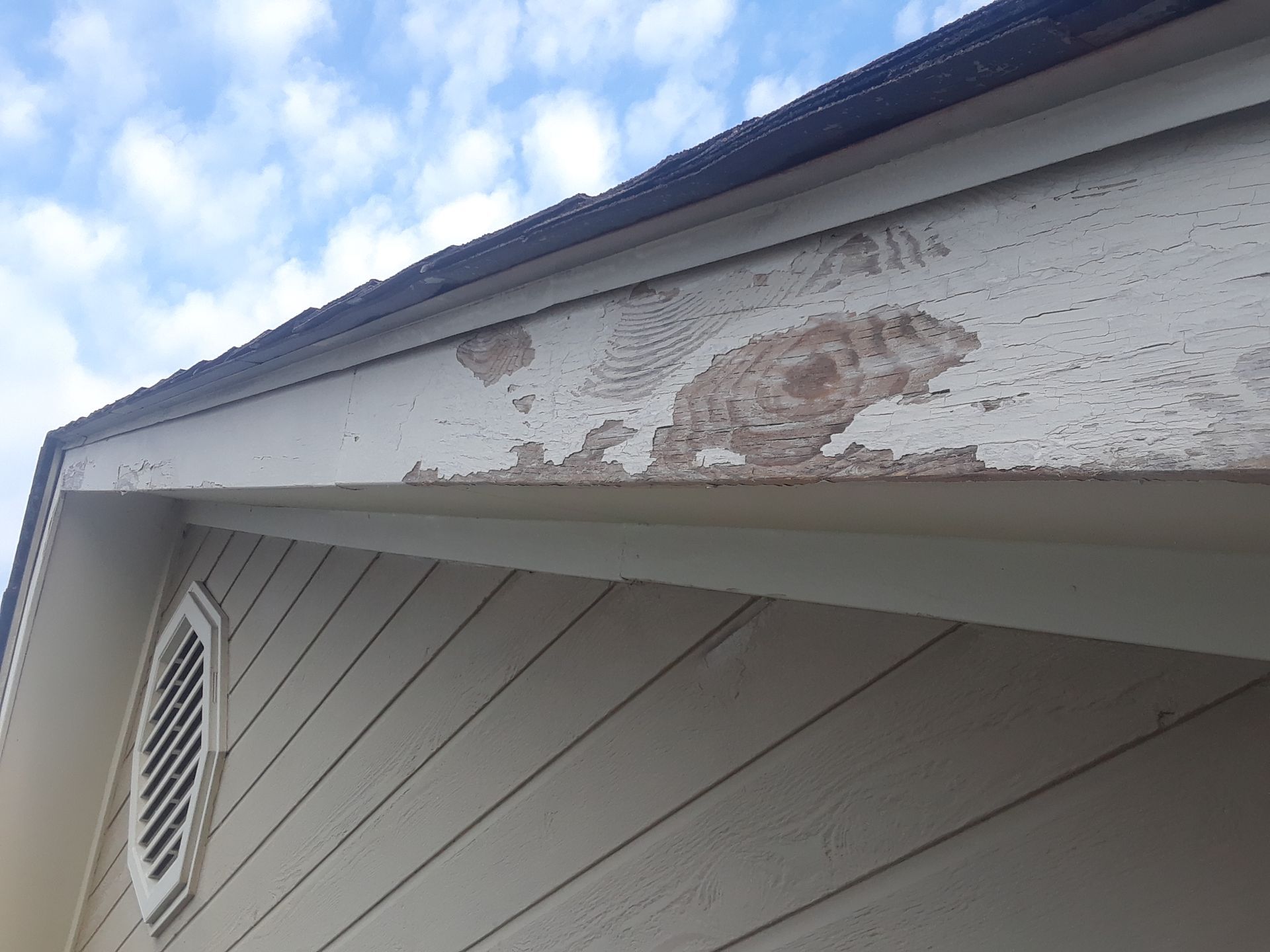Prevent further damage by tackling peeling paint on your house ASAP
Seeing your home's once-vibrant exterior succumb to peeling paint can be disheartening, can't it?
It's like watching a cherished garment fade and fray before your very eyes. But just as a skillful tailor can breathe new life into a beloved piece of clothing, so too can an exterior paint job restore your home's protective barrier and curb appeal. Indeed, beneath the surface of that flaking facade lies an opportunity for transformation, where a touch of expertise can usher in a fresh era for your abode.

Identifying Causes of Peeling Paint
Peeling paint is often a telltale sign of deeper issues that need attention. It may stem from environmental stressors like extreme temperatures, high humidity, or prolonged exposure to sunlight. These elements can break down the paint's integrity, leading to the unsightly and damaging peels you observe on your home’s exterior.
Factors within the home, such as improper prior paint application or moisture intrusion, can also provoke peeling. Knowing the culprit is key to choosing the right solution and ensuring a resilient and enduring exterior paint job.
Moisture Damage Warnings
Peeling paint often signals underlying moisture issues—critical for homeowners to address promptly to prevent further damage.
Exterior paint degradation accelerates with moisture presence, reducing the lifespan of your home's protective skin.
Resolving moisture problems at the outset ensures a durable paint job. Ignoring them can lead to extensive repairs and potentially structural damage.
Consistent inspection and maintenance of your home's exterior is essential. It helps catch early signs of moisture trouble, safeguarding your investment and maintaining your home's aesthetic.
Sun Exposure and Paint Deterioration
Intense UV rays relentlessly pummel your home's exterior, causing the once vibrant paint to fade, crack, and peel.
Over time, this solar assault weakens the paint's binding agents, leading to brittleness and eventual flaking. This degradation isn't just cosmetic—it's a breach in your home's armor.
The angle of sunlight exposure can affect different parts of your house unevenly, accelerating wear on sun-struck areas. South-facing walls often bear the brunt, necessitating more frequent touch-ups or repaints.
Higher-quality paints with UV inhibitors can mitigate some damage, yet no product is entirely immune to the sun's persistent rays. Regular monitoring for signs of deterioration helps catch issues before they escalate.
Applying a fresh coat of paint, suited to withstand UV radiation, is the best defense against the sun's relentless energy. Maintenance is key to safeguarding your home's exterior charm.
Initial Steps Before Repainting
Before you dive into slapping on a new coat, a proper assessment of the situation is crucial. Peeling paint indicates that the previous layer hasn't bonded well, which can stem from various underlying issues such as moisture or poor adhesion. Identifying and rectifying these root causes will be vital to ensure your new paint adheres and stands the test of time.
As you prepare for a fresh start, think of it as "setting the stage." Begin with a clean canvas by thoroughly washing the affected area, removing all loose and peeling paint. During this process, also keep an eye out for any signs of damage to the surface. Repairing imperfections now will spare you from future headaches and will provide the even, smooth foundation necessary for a professional-quality finish.
Assessing the Extent of Damage
Before you embark on repainting, it's important to scrutinize the peeling areas. Carefully examine the entire house, noting the severity and location of the flaking paint. This initial survey sets the stage for the remediation process, pinpointing the areas in need of the most attention.
Don't overlook small, seemingly inconsequential spots. They may signal broader underlying issues that could spread if not addressed.
In particular, focus on the areas with direct sun exposure. Ultraviolet rays are notorious for accelerating degradation and may highlight problematic zones.
Also, assess any wood surfaces for rotting or warping. If the wood beneath the paint is compromised, simply painting over it won't solve the root problem. Here, replacement or structural repairs take precedence over mere cosmetic fixes.
Delamination of the paint could be telling of the wall's overall health. Pay attention to any signs of persistent moisture or mildew, which may necessitate more extensive remediation before a new coat of paint is applied.
Finally, be sure to check around windows, doors, and trim for special attention areas. These junctions often have distinct challenges and need tailored approaches before proceeding with painting.
Cleaning and Preparing Surfaces
Before diving into a new paint job, getting your exterior surfaces squeaky clean is essential.
- Remove Loose Paint: Use a paint scraper or a stiff-bristle brush to scrape off any flaking or peeling paint.
- Wash the Surface: Employ a pressure washer or a strong hose spray to remove dirt, mildew, and remnants of old paint.
- Repair Damages: Fill in any cracks or holes with exterior-grade patching compound and sand any rough areas.
- Apply Primer: Once dry, treat bare wood or metal areas with a quality exterior primer to ensure proper paint adhesion.
- Tape and Cover: Mask off areas you don't want painted like windows, doors, and light fixtures, and lay drop cloths to protect the ground.
This prep work is critical for a durable, long-lasting paint job.
And I can't emphasize this enough: make sure everything is completely dry before you even think about opening that paint can.
Choosing the Right Paint and Tools
Embarking on the paint selection journey can feel like navigating a maze with countless turns and options. It's crucial to select a high-quality exterior paint specifically formulated for your home's surface—whether it's wood, stucco, metal, or vinyl. Such paints come with additives that resist mildew and fading and improve adhesion. Now, let's talk tools: a sturdy ladder, reliable brushes of various sizes, a paint roller setup for larger areas, and, for those hard-to-reach spots, possibly an extension pole. Choosing the right arsenal will not only streamline the process but ensure a more professional, enduring result, making your hard work last for years to come.
Matching Paint Types
When the old paint is peeling off your house, it's not just about scraping and getting down to a solid surface. You must match the type of paint precisely; otherwise, the new layer might not adhere correctly or could have a different finish. Compatibility between layers ensures that your new paint bonds well.
It's a dance between chemistry and aesthetics. You'll have to determine whether the existing paint is oil-based or latex. These are quite distinct in their application and drying processes, and mixing them can lead to a poor finish.
Remember, latex paint can go over oil-based primer, but never the reverse without proper surface preparation. The telltale sign of trouble is the new paint wrinkling or not drying evenly.
If you've identified the original paint as oil-based, stick with that for your new coat. Upgrading to a higher-quality version can offer enhanced durability and better coverage, particularly if you're dealing with challenging exterior conditions.
For continuity in appearance and protection, it's essential to use the same sheen level. If your old paint was flat, gloss, or satin, replicate that to ensure the new paint doesn't visually stand out.
Lastly, if the color needs to be replicated, bring a chip to your paint store. They can often precisely match your home's unique hue, ensuring a seamless transition between old and new paint areas.
Investing in Quality Supplies
Choosing the right supplies is crucial for a long-lasting, resilient paint job.
- High-quality exterior primer: Ensures better adhesion and durability of the topcoat.
- Premium paints: Formulated with higher quality resins, pigments, and additives that resist peeling and fading.
- Top-tier brushes and rollers: Provide smoother application and better coverage, reducing streaks and imperfections.
- Durable caulk: Prevents water infiltration and further damage to the exterior.
- Heavy-duty cleaners: Essential for properly preparing surfaces before painting.
Invest a little more upfront, and save on future repairs and repaints.
Using subpar paint might save you a few bucks now, but it's a false economy—bet on the best to keep your home looking great and staying protected.
Painting Techniques for Durability
Applying paint in even, methodical strokes, with a focus on consistent thickness, does more than just appeal to the eye. It promotes a uniform seal against the elements, reducing the likelihood that your new coat of paint prematurely deteriorates. Moreover, this approach helps avoid areas of excessive thickness where paint is more prone to cracking and peeling, aiding in the overall longevity of your home's façade.
For enduring results, consider adopting a "wet on wet" painting technique. This involves adding a new coat of paint while the previous layer is still somewhat tacky. This method encourages strong adhesion between layers, minimizing the chance of peeling. In regions with fluctuating temperatures, this can be particularly advantageous, as it reinforces the defense against the expansion and contraction that can cause paint to crack or peel.
Effective Application Strategies
Opt for a high-quality primer to establish a solid base. The primer's job is to provide a consistent, adhesive surface that ensures a strong bond with the top coat of paint.
When it comes to the painting process, timing is everything. Apply paints during cooler, overcast days to prevent rapid drying, which can lead to an uneven finish and less optimal adhesion.
Always keep the "feathered edge" technique in your arsenal. By lightly brushing outwards, you avoid creating hard paint lines, allowing for seamless layering and integration of the paint coats.
Remember to respect the drying time. Rushing to re-coat can trap moisture and solvents, leading to blistering and peeling. A patient approach sets the stage for a pristine, enduring exterior.
Lastly, maintain a meticulous edge. Precise boundaries where colors meet ensure a professional appearance and prevent areas prone to wear from being overlooked during application.
Seasonal Considerations for Exterior Paint
Timing and climate can make or break your exterior painting project.
- Spring: Mild temperatures and lower humidity create ideal painting conditions; just watch out for those unpredictable rain showers.
- Summer: Aim for early summer to avoid the scorching heat that can cause paint to dry too quickly and unevenly.
- Autumn: This is another sweet spot, but be sure to paint early in the season before temperatures plummet.
- Winter: Generally not recommended, but if necessary, choose a day with temperatures above 50°F and no precipitation.
Choosing the right time of year for painting can save you from redoing the job too soon.
Remember, Mother Nature waits for no one—plan your painting around her schedule to get the best results.
Hiring A Professional Painting Contractor
Peeling paint is like a persistent itch—it must be dealt with, and promptly so. Give Peninsula Painting Services a call and let us help bring your homes curb appeal back to life.
Hiring a professional painting contractor can make all the difference when tackling an exterior paint job, especially one involving peeling paint. These experts come equipped with the tools and experience to properly prepare the surface, identify the root causes of peeling, and apply the best solutions. They can tackle environmental factors and choose the right products that will stand up to your specific climate challenges.
Beyond experiential skill, these professionals bring an understanding of the technical aspects of painting. They understand the chemistry of paint products, ensuring compatibility and durability. Plus, they'll know how to safely address any lead paint that might be uncovered during the project—a very real concern for older homes.
In summary, peace of mind is the real value of hiring a seasoned painting pro. Investing a bit more upfront can often mean saving on costly do-overs down the line. They'll ensure proper surface prep, application, and finishing touches that only a trained eye can provide. With their help, your home's curb appeal will be protected, preserving your investment for years to come.
You might also like

Book A Service Today


